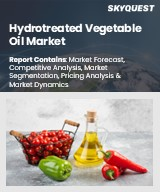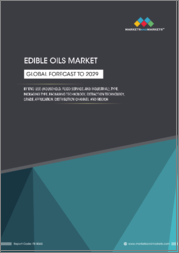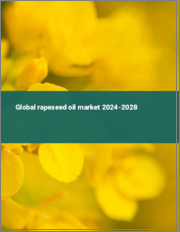
|
시장보고서
상품코드
1572508
유채유 시장 : 기회, 성장 촉진요인, 산업 동향 분석 및 예측(2024-2032년)Rapeseed Oil Market, Opportunity, Growth Drivers, Industry Trend Analysis and Forecast, 2024-2032 |
||||||
세계 유채유 시장은 2023년 225억 달러로 평가되었고, 2024년부터 2032년까지 연평균 5.2% 이상 성장할 것으로 예상됩니다.
건강에 대한 관심 증가와 식물성 식습관 트렌드가 이러한 성장을 주도하고 있습니다. 미국 농무부(USDA)의 보고에 따르면, 유채유에 대한 식품 수요는 15% 증가했으며, 바이오디젤 생산에 사용되는 유채유는 10% 증가했다고 합니다. 이는 특히 유럽과 미국에서 유채유가 다른 식물성 기름을 대체할 수 있는 지속 가능한 대안이 될 수 있다는 것을 보여줍니다.
유채유 산업 동향은 자연적이고 건강한 선택을 선호하는 소비자의 경향에 힘입어 유기농 및 유전자 변형이 없는 제품으로의 전환을 보여주고 있습니다. 미국 농무부는 유기농 식품 판매가 10% 증가했다고 밝혔습니다. 또한, 유채 기름의 환경에 대한 긍정적인 프로파일은 특히 바이오 디젤 생산에서 산업적 용도에 대한 관심을 불러 일으켜 USDA에 따르면 15% 증가를보고 있습니다. 추출 방법의 기술 발전은 유채 기름의 품질과 수율을 모두 향상시켜 식품에서 재생 가능 에너지에 이르기까지 다양한 분야에서 채택되고 있습니다.
2032년까지 241억 달러에 달할 것으로 예상되는 정제 유채유 분야는 예측 기간 동안 4.9% 이상의 CAGR로 성장할 것으로 예상됩니다. 정제된 유채유는 다양한 용도와 폭넓은 용도로 각광받고 있습니다. 중성적인 맛, 높은 발연점, 높은 영양가로 인해 요리, 제빵 및 식품 가공에 선호됩니다. 정제 공정은 안정성과 저장성을 향상시켜 소비자와 제조업체 모두에게 어필할 수 있습니다. 정제된 유채유는 요리 용도 외에도 화장품 및 제약 산업에서 점점 더 많이 사용되고 있습니다. 더 건강하고 다기능적인 오일에 대한 수요가 증가함에 따라 정제된 유채유는 지속적인 성장을 기대할 수 있습니다.
유채유 시장 점유율은 2032년까지 152억 달러에 달할 것으로 예상됩니다. 낮은 포화지방, 높은 오메가3 지방산 함량 등 건강상의 이점으로 인해 유채유는 음료 및 식품 분야의 선두주자가 되었습니다. 중성적인 맛과 높은 발연점으로 인해 요리, 제빵, 샐러드 드레싱 및 가공 식품에 이상적입니다. 소비자의 건강 지향적 성향에 따라 유채유는 다른 식물성 기름보다 선호되는 선택이 되고 있습니다. 유채유는 마가린, 스프레드, 유화제 제조에도 필수적입니다. 식물성 식단의 부상과 클린 라벨 원료에 대한 수요로 인해 식음료 산업에서 유채유는 점점 더 큰 영향력을 발휘하고 있습니다.
2032년 아시아태평양 유채유 시장은 2024년부터 2032년까지 연평균 5.4%의 성장률을 기록하며 145억 달러에 달할 것으로 예상됩니다. 도시화, 가처분 소득 증가, 건강과 영양에 대한 관심 증가는 아시아태평양 시장 성장의 원동력이 되고 있습니다. 이 지역은 식음료 산업이 발달하여 건강 지향적인 식용유에 대한 수요가 증가하고 있습니다. 또한, 지속 가능한 농업과 바이오연료 생산에 대한 정부의 지원은 유채유 부문을 강화하고 있습니다. 소비자들이 건강과 식물성 식단을 우선시함에 따라 유채유에 대한 수요는 요리용과 산업용 모두에서 증가할 것으로 예상되며, 이는 아시아태평양 시장 성장에 큰 기회를 제공할 것으로 보입니다.
목차
제1장 조사 방법과 조사 범위
제2장 주요 요약
제3장 업계 인사이트
- 생태계 분석
- 주요 제조업체
- 유통업체
- 업계 전체 이익률
- 업계에 대한 영향요인
- 건강과 영양에 대한 소비자 의식의 고양
- 식물 기반 식사와 채식 주의 인기 증대
- 바이오연료 산업 확대
- 시장이 해결해야 할 과제
- 유채 가격 변동
- 기타 기름과의 경쟁
- 시장 기회
- 새로운 기회
- 성장 가능성 분석
- 원료 상황
- 제조 동향
- 기술 진화
- 지속가능한 제조
- 그린 프랙티스
- 탈탄소화
- 지속가능한 제조
- 원재료의 지속가능성
- 가격 동향(달러/톤), 2021-2032년
- 규제와 시장에 대한 영향
- Porter's Five Forces 분석
- PESTEL 분석
제4장 경쟁 구도
- 기업 점유율 분석
- 경쟁 포지셔닝 매트릭스
- 전략 전망 매트릭스
제5장 시장 규모와 예측 : 제품 유형별, 2021년-2032년
- 주요 동향
- 정제 유채유
- 조제 유채유
- 유기 유채유
제6장 시장 규모와 예측 : 용도별, 2021년-2032년
- 주요 동향
- 식품 및 음료
- 산업
- 사료
- 의약품
- 기타(바이오폴리머, 농약 포함)
제7장 시장 규모와 예측 : 유통 채널별, 2021년-2032년
- 주요 동향
- 소매점
- 온라인 소매
- 유통업체
- 직접 판매
제8장 시장 규모와 예측 : 지역별, 2021년-2032년
- 주요 동향
- 북미
- 미국
- 캐나다
- 유럽
- 독일
- 영국
- 프랑스
- 이탈리아
- 스페인
- 기타 유럽
- 아시아태평양
- 중국
- 인도
- 일본
- 한국
- 호주
- 기타 아시아태평양
- 라틴아메리카
- 브라질
- 멕시코
- 아르헨티나
- 기타 라틴아메리카
- 중동 및 아프리카
- 사우디아라비아
- 아랍에미리트(UAE)
- 남아프리카공화국
- 기타 중동 및 아프리카
제9장 기업 개요
- Wilmar
- Vioil
- Interfat
- Cargill Inc.
- Adani Wilmar Ltd.
- American Vegetable Oils Inc.
- Marico Limited
- Grief Inc.
- Associated British Foods Plc.
- Fuji Oil Holdings Inc.
- ADM
The Global Rapeseed Oil Market was valued at USD 22.5 billion in 2023 and is projected to grow at a CAGR of over 5.2% from 2024 to 2032. Increasing health consciousness and the rising trend of plant-based diets drive this growth. The United States Department of Agriculture (USDA) reports a 15% increase in rapeseed oil demand for food products and a 10% rise in its use for biodiesel production. This highlights rapeseed oil's potential as a sustainable alternative to other vegetable oils, particularly in Europe and North America.
Trends in the rapeseed oil industry show a shift towards organic and non-GMO products, driven by consumers' preference for natural and healthier options. The USDA notes a 10% rise in organic food sales. Moreover, the positive environmental profile of rapeseed oil has sparked interest in its industrial uses, notably in biodiesel production, which has seen a 15% increase according to the USDA. Technological advancements in extraction methods are improving both the quality and yield of rapeseed oil, leading to its adoption across various sectors, from food to renewable energy.
The overall rapeseed oil market is divided based on product type, application, distribution channel, and region.
Projected to reach USD 24.1 billion by 2032, the refined rapeseed oil segment is set to grow at a CAGR of over 4.9% over the forecast period. Refined rapeseed oil is gaining prominence due to its versatility and wide-ranging applications. Its neutral flavor, high smoke point, and nutritional benefits make it a preferred choice for cooking, baking, and food processing. The refining process enhances stability and shelf life, appealing to both consumers and manufacturers. Beyond culinary applications, refined rapeseed oil is increasingly used in the cosmetic and pharmaceutical industries. With rising demand for healthier and multifunctional oils, refined rapeseed oil is well-positioned for continued growth.
The rapeseed oil market share from food and beverages is expected to reach USD 15.2 billion by 2032. Its health benefits, including low saturated fat and high omega-3 fatty acid content, establish rapeseed oil as a strong player in the food and beverage sector. Its neutral flavor and high smoke point make it ideal for cooking, baking, salad dressings, and processed foods. As consumers lean towards healthier options, rapeseed oil is becoming the preferred choice over other vegetable oils. It's also essential in producing margarine, spreads, and emulsifiers. With the rise of plant-based diets and demand for clean-label ingredients, rapeseed oil's prominence in the food and beverage industry is increasing.
In 2032, Asia Pacific rapeseed oil market is projected to reach USD 14.5 billion, growing at a CAGR of 5.4% from 2024 to 2032. Urbanization, increasing disposable incomes, and a heightened focus on health and nutrition drive the market's growth in the Asia-Pacific region. The region's thriving food and beverage industry boosts the demand for health-oriented cooking oils. Additionally, government support for sustainable agricultural practices and biofuel production strengthens the rapeseed oil sector. As consumers prioritize health and plant-based diets, the demand for rapeseed oil in both culinary and industrial applications is expected to rise, presenting significant opportunities for market growth in the Asia-Pacific region.
Table of Contents
Chapter 1 Methodology and Scope
- 1.1 Market scope and definition
- 1.2 Base estimates and calculations
- 1.3 Forecast calculation
- 1.4 Data sources
- 1.4.1 Primary
- 1.4.2 Secondary
- 1.4.2.1 Paid sources
- 1.4.2.2 Public sources
Chapter 2 Executive Summary
- 2.1 Industry 360° synopsis
Chapter 3 Industry Insights
- 3.1 Industry ecosystem analysis
- 3.1.1 Key manufacturers
- 3.1.2 Distributors
- 3.1.3 Profit margins across the industry
- 3.2 Industry impact forces
- 3.2.1 Increasing consumer awareness of health and nutrition
- 3.2.2 Growing popularity of plant-based diets and vegetarianism
- 3.2.3 Expansion of the biofuel industry
- 3.2.4 Market challenges
- 3.2.4.1 Fluctuations in rapeseed prices
- 3.2.4.2 Competition from other oils
- 3.2.5 Market opportunity
- 3.2.5.1 New opportunities
- 3.2.5.2 Growth potential analysis
- 3.3 Raw material landscape
- 3.3.1 Manufacturing trends
- 3.3.2 Technology evolution
- 3.3.2.1 Sustainable manufacturing
- 3.3.2.1.1 Green practices
- 3.3.2.1.2 Decarbonization
- 3.3.2.1 Sustainable manufacturing
- 3.3.3 Sustainability in raw materials
- 3.3.4 Pricing trends (USD/Ton), 2021 - 2032
- 3.3.4.1 North America
- 3.3.4.2 Europe
- 3.3.4.3 Asia Pacific
- 3.3.4.4 Latin America
- 3.3.4.5 Middle East and Africa
- 3.4 Regulations and market impact
- 3.5 Porter's analysis
- 3.6 PESTEL analysis
Chapter 4 Competitive Landscape, 2023
- 4.1 Company market share analysis
- 4.2 Competitive positioning matrix
- 4.3 Strategic outlook matrix
Chapter 5 Market Size and Forecast, By Product Type, 2021-2032 (USD Billion, Kilo Tons)
- 5.1 Key trends
- 5.2 Refined rapeseed oil
- 5.3 Crude rapeseed oil
- 5.4 Organic rapeseed oil
Chapter 6 Market Size and Forecast, By Application, 2021-2032 (USD Billion, Kilo Tons)
- 6.1 Key trends
- 6.2 Food and beverages
- 6.3 Industrial use
- 6.4 Animal feed
- 6.5 Pharmaceuticals
- 6.6 Others (including biopolymers, agricultural chemicals)
Chapter 7 Market Size and Forecast, By Distribution Channel, 2021-2032 (USD Billion, Kilo Tons)
- 7.1 Key trends
- 7.2 Retail stores
- 7.3 Online retail
- 7.4 Distributors
- 7.5 Direct sales
Chapter 8 Market Size and Forecast, By Region, 2021-2032 (USD Billion, Kilo Tons)
- 8.1 Key trends
- 8.2 North America
- 8.2.1 U.S.
- 8.2.2 Canada
- 8.3 Europe
- 8.3.1 Germany
- 8.3.2 UK
- 8.3.3 France
- 8.3.4 Italy
- 8.3.5 Spain
- 8.3.6 Rest of Europe
- 8.4 Asia Pacific
- 8.4.1 China
- 8.4.2 India
- 8.4.3 Japan
- 8.4.4 South Korea
- 8.4.5 Australia
- 8.4.6 Rest of Asia Pacific
- 8.5 Latin America
- 8.5.1 Brazil
- 8.5.2 Mexico
- 8.5.3 Argentina
- 8.5.4 Rest of Latin America
- 8.6 MEA
- 8.6.1 Saudi Arabia
- 8.6.2 UAE
- 8.6.3 South Africa
- 8.6.4 Rest of MEA
Chapter 9 Company Profiles
- 9.1 Wilmar
- 9.2 Vioil
- 9.3 Interfat
- 9.4 Cargill Inc.
- 9.5 Adani Wilmar Ltd.
- 9.6 American Vegetable Oils Inc.
- 9.7 Marico Limited
- 9.8 Grief Inc.
- 9.9 Associated British Foods Plc.
- 9.10 Fuji Oil Holdings Inc.
- 9.11 ADM
















